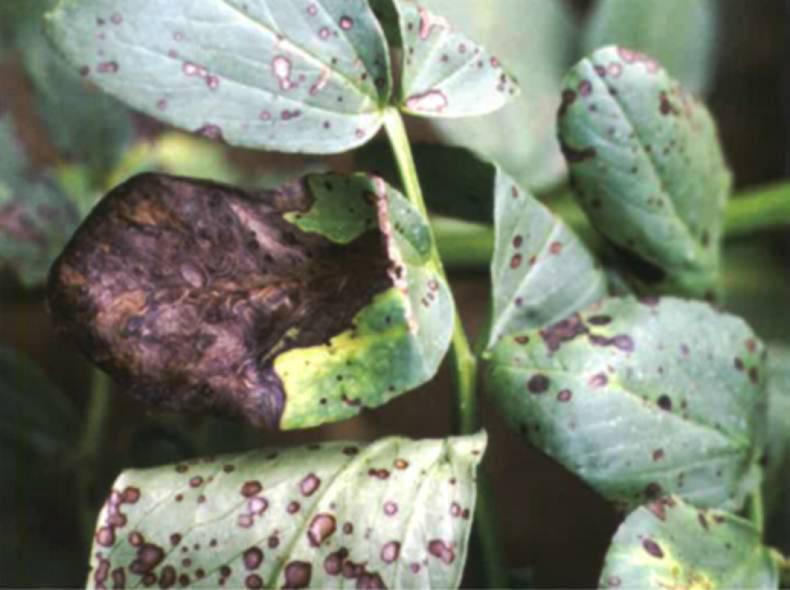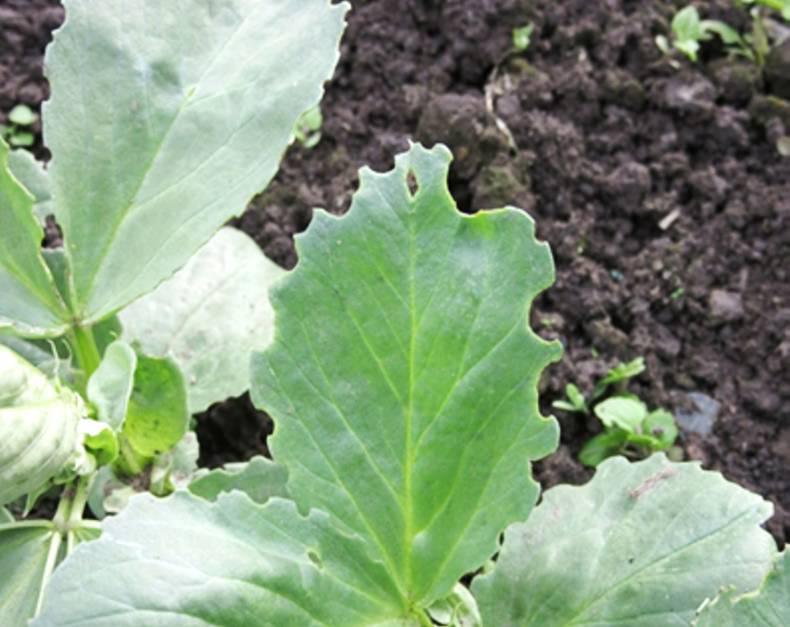The area of beans increased substantially in 2015 to over 9,500ha. This means that many growers were first-time growers in 2015 and there will be other first-time growers this year. While beans are a relatively simple and straightforward crop to grow, and the crop had a very good year in 2015, basic good management is essential to help ensure crop performance. At this point, I assume that crops are adequately fertilised in terms of pH and P ad K in particular, and also trace elements. This article deals mainly with management post-emergence up to harvest.
Weed control
Weeds may be visible in beans following the relatively dry weather. Field experience suggests that rain will re-activate pre-emergence herbicides in May and into June, so the advice is to wait before considering a follow-up spray.
Products containing clomazone can cause a bleaching effect after emergence, particularly if there have been wet conditions following application. The early bleaching disappears over time, but can reappear if wet conditions return later in the crop’s development. This does not affect yield.
Post-emergence options are limited and have a narrow window of application to get best effects. Bentazone, with a methylated rapeseed oil, can be used where charlock/volunteer rape are problematic, but only before seven leaf-pairs.
There are no herbicides to control thistles and docks – products containing MCPB, MCPA or clopyralid are damaging to beans. The best method of weed control in beans is to ensure a good, even plant stand.
Beans give good opportunity for control of grass weeds, which may have become problematic in cereal crops. A number of graminicides are available for wild oat, scutch, sterile brome and other grass weed control. Check rates and labels as some products must only be used before the first flower bud is visible.
Pest control
The main pest of interest is bean weevil. Adult weevils migrate from their over-wintering sites, mainly around field margins, especially if the field or neighbouring fields have been previously cropped with peas or beans. Migration occurs early in the spring and this often coincides with short periods, where the maximum air temperature exceeds 15°C.

The pest can cause damage to spring beans if large numbers appear when plants are small. Leaves of attacked plants show characteristic U-shaped notches around the edges (picture one above), but the main damage occurs as a result of the larvae feeding on the root nodules. Once crops emerge, monitor crops for leaf-notching and if damage is seen across the crop, apply a suitable insecticide.
Pyrethroids work by direct contact during spraying, with some also being picked up from the plant for a short period (five to seven days) after application. Pyrethroids bind tightly to soil, so treated soil will have very little positive effect on pest control.
Teagasc has set up five pea and bean weevil monitoring stations (Table 1) using pheromone traps supplied by PGRO in the UK. These act as an indication of weevil activity and likely attack in bean crops. In conjunction with weather data from nearby met stations, these traps are part of an early warning system being investigated by PGRO and Teagasc.
Bruchid beetle, which had been absent in Ireland, was found in seed samples from the 2015 harvest. Teagasc will be monitoring its presence in the coming season.
![]()
Black bean aphid colonisation of individual plants can occur in late summer (picture two above). Heavily infested individual plants will be badly damaged, but treatment is not necessary unless more than 5% (1 in 20) of plants are heavily colonised. This is because more physical damage may be caused by the spraying operation in the maturing crop than by the feeding aphids.
Disease control
Chocolate spot (Botrytis fabae) is the main threat to beans, but this disease was virtually absent in 2014 and 2015 crops due to the dry weather.
Symptoms appear as brown spots, which eventually enlarge to a more aggressive phase in cool, wet or damp weather (picture three below).

Yield losses of up to 50% can be seen in high-pressure years. High-density plant stands will lead to increased pressure and disease spread. Usually, a two-spray programme is recommended and early spraying is critical to achieve good control, as no curative chemistry is available.
Spray at first signs of infection, which will usually occur at start of flowering (or earlier in coastal areas) and repeat two to three weeks later. Options include Strobilurin + chlorothalonil/tebuconazole or Boscalid + Strobilurin. Products will also give some control of Ascochyta.
Downy mildew is prevalent on spring beans, where it causes greyish-brown, felty growth on the under-surface of the leaves. Some varieties have resistance to the disease. Treat with mancozeb at start of flowering. This has mainly protective properties. Earlier treatment was not beneficial in NIAB trials but early infection should be monitored. Products containing metylaxyl offer some curative control.
Bean rust is usually not problematic and will be well controlled by the products applied for chocolate spot control.
Desiccation and harvest
With the delayed sowing of most spring bean crops due to the wet spring, it is almost inevitable that harvest will be pushed back to late September, or even later. Crops need to be allowed to ripen naturally. Neither diquat nor glyphosate will speed the ripening process.
However, once 90% of pods are black, diquat can help to dry up stems and small late-filling pods. In crops with large weed populations, glyphosate applied pre-harvest provides an excellent opportunity for the control of problem perennial broadleaved species, but it must not be used in crops for seed. It should be applied when all the pods are dry and black, and the seed is hard, with moisture content 30% or less.
The area of beans increased substantially in 2015 to over 9,500ha. This means that many growers were first-time growers in 2015 and there will be other first-time growers this year. While beans are a relatively simple and straightforward crop to grow, and the crop had a very good year in 2015, basic good management is essential to help ensure crop performance. At this point, I assume that crops are adequately fertilised in terms of pH and P ad K in particular, and also trace elements. This article deals mainly with management post-emergence up to harvest.
Weed control
Weeds may be visible in beans following the relatively dry weather. Field experience suggests that rain will re-activate pre-emergence herbicides in May and into June, so the advice is to wait before considering a follow-up spray.
Products containing clomazone can cause a bleaching effect after emergence, particularly if there have been wet conditions following application. The early bleaching disappears over time, but can reappear if wet conditions return later in the crop’s development. This does not affect yield.
Post-emergence options are limited and have a narrow window of application to get best effects. Bentazone, with a methylated rapeseed oil, can be used where charlock/volunteer rape are problematic, but only before seven leaf-pairs.
There are no herbicides to control thistles and docks – products containing MCPB, MCPA or clopyralid are damaging to beans. The best method of weed control in beans is to ensure a good, even plant stand.
Beans give good opportunity for control of grass weeds, which may have become problematic in cereal crops. A number of graminicides are available for wild oat, scutch, sterile brome and other grass weed control. Check rates and labels as some products must only be used before the first flower bud is visible.
Pest control
The main pest of interest is bean weevil. Adult weevils migrate from their over-wintering sites, mainly around field margins, especially if the field or neighbouring fields have been previously cropped with peas or beans. Migration occurs early in the spring and this often coincides with short periods, where the maximum air temperature exceeds 15°C.

The pest can cause damage to spring beans if large numbers appear when plants are small. Leaves of attacked plants show characteristic U-shaped notches around the edges (picture one above), but the main damage occurs as a result of the larvae feeding on the root nodules. Once crops emerge, monitor crops for leaf-notching and if damage is seen across the crop, apply a suitable insecticide.
Pyrethroids work by direct contact during spraying, with some also being picked up from the plant for a short period (five to seven days) after application. Pyrethroids bind tightly to soil, so treated soil will have very little positive effect on pest control.
Teagasc has set up five pea and bean weevil monitoring stations (Table 1) using pheromone traps supplied by PGRO in the UK. These act as an indication of weevil activity and likely attack in bean crops. In conjunction with weather data from nearby met stations, these traps are part of an early warning system being investigated by PGRO and Teagasc.
Bruchid beetle, which had been absent in Ireland, was found in seed samples from the 2015 harvest. Teagasc will be monitoring its presence in the coming season.
![]()
Black bean aphid colonisation of individual plants can occur in late summer (picture two above). Heavily infested individual plants will be badly damaged, but treatment is not necessary unless more than 5% (1 in 20) of plants are heavily colonised. This is because more physical damage may be caused by the spraying operation in the maturing crop than by the feeding aphids.
Disease control
Chocolate spot (Botrytis fabae) is the main threat to beans, but this disease was virtually absent in 2014 and 2015 crops due to the dry weather.
Symptoms appear as brown spots, which eventually enlarge to a more aggressive phase in cool, wet or damp weather (picture three below).

Yield losses of up to 50% can be seen in high-pressure years. High-density plant stands will lead to increased pressure and disease spread. Usually, a two-spray programme is recommended and early spraying is critical to achieve good control, as no curative chemistry is available.
Spray at first signs of infection, which will usually occur at start of flowering (or earlier in coastal areas) and repeat two to three weeks later. Options include Strobilurin + chlorothalonil/tebuconazole or Boscalid + Strobilurin. Products will also give some control of Ascochyta.
Downy mildew is prevalent on spring beans, where it causes greyish-brown, felty growth on the under-surface of the leaves. Some varieties have resistance to the disease. Treat with mancozeb at start of flowering. This has mainly protective properties. Earlier treatment was not beneficial in NIAB trials but early infection should be monitored. Products containing metylaxyl offer some curative control.
Bean rust is usually not problematic and will be well controlled by the products applied for chocolate spot control.
Desiccation and harvest
With the delayed sowing of most spring bean crops due to the wet spring, it is almost inevitable that harvest will be pushed back to late September, or even later. Crops need to be allowed to ripen naturally. Neither diquat nor glyphosate will speed the ripening process.
However, once 90% of pods are black, diquat can help to dry up stems and small late-filling pods. In crops with large weed populations, glyphosate applied pre-harvest provides an excellent opportunity for the control of problem perennial broadleaved species, but it must not be used in crops for seed. It should be applied when all the pods are dry and black, and the seed is hard, with moisture content 30% or less.
Watch crops for weed control, which may be affected by the dry spell post-planting. There are many pests that need to be watched and monitored but control may not be necessary in many cases.Control of diseases is important and most products are preventative.Crop desiccation is of little benefit to bring the crops to maturity but desiccants may be necessary for other reasons. 







 This is a subscriber-only article
This is a subscriber-only article













SHARING OPTIONS: